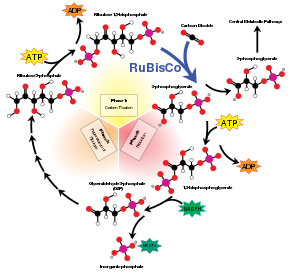Calvin cycle
The Calvin cycle (also known as the Benson-Calvin cycle) is the set of chemical reactions that take place in chloroplasts during photosynthesis.

The cycle is light-independent because it takes place after the energy has been captured from sunlight.
The Calvin cycle is named after Melvin Calvin, who won a Nobel Prize in Chemistry for finding it in 1961.[1] Calvin and his colleagues, Andrew Benson and James Bassham, did the work at the University of California, Berkeley.[2]
Context
changeUsing the radioactive carbon-14 isotope as a tracer, Calvin, Andrew Benson and their team mapped the complete route that carbon travels through a plant during photosynthesis. They traced the carbon-14 from soaking up its atmospheric carbon dioxide to its conversion into carbohydrates and other organic compounds.[3][4] The single-celled algae Chlorella was used to trace the carbon-14.[5]
The Calvin group showed that sunlight acts on the chlorophyll in a plant to fuel the manufacture of organic compounds, not directly on carbon dioxide as previously believed.
Steps
changeThe steps in the cycle are as follows:[6]
1. Grab: A five-carbon carbon catcher called RuBP (Ribulose bisphosphate) catches one molecule of carbon dioxide and forms a six-carbon molecule.
2. Split: the enzyme RuBisCO (with the energy of ATP and NADPH molecules) breaks the six-carbon molecule into two equal parts.
3. Leave: A trio of carbons leave and become sugar. The other trio moves on to the next step.
4. Switch: Using ATP and NADPH, the three-carbon molecule is changed into a five-carbon molecule.
5. The cycle starts over again.
The product
changeThe carbohydrate products of the Calvin cycle are three-carbon sugar phosphate molecules, or 'glucose triose phosphates' (G3P). Each step of the cycle has its own enzyme which speeds up the reaction.
References
change- ↑ "The Nobel Prize in Chemistry 1961 Melvin Calvin". nobelprize.org. Retrieved January 14, 2011.
- ↑ Bassham J, Benson A, Calvin M (1950). "The path of carbon in photosynthesis". J Biol Chem. 185 (2): 781–7. doi:10.1016/S0021-9258(18)56368-7. PMID 14774424.
{{cite journal}}: CS1 maint: multiple names: authors list (link) - ↑ Calvin M. 1956 (1956), "The photosynthetic cycle.", Bull. Soc. Chim. Biol., vol. 38, no. 11, pp. 1233–44, PMID 13383309
{{citation}}: CS1 maint: numeric names: authors list (link) - ↑ Barker S.A. et al 1956 (1956), "Intermediates in the photosynthetic cycle.", Biochim. Biophys. Acta, vol. 21, no. 2, pp. 376–7, doi:10.1016/0006-3002(56)90022-1, PMID 13363921, S2CID 2051618
{{citation}}: CS1 maint: numeric names: authors list (link) - ↑ Calvin, Melvin 1961. "The path of carbon in photosynthesis" (PDF). p. 4. Retrieved July 11, 2011.
{{cite web}}: CS1 maint: numeric names: authors list (link) - ↑ Sadava, David et al 2009 (2011). Life: the science of biology. Macmillan, p199–202. ISBN 978-1429219624.
{{cite book}}: CS1 maint: numeric names: authors list (link)